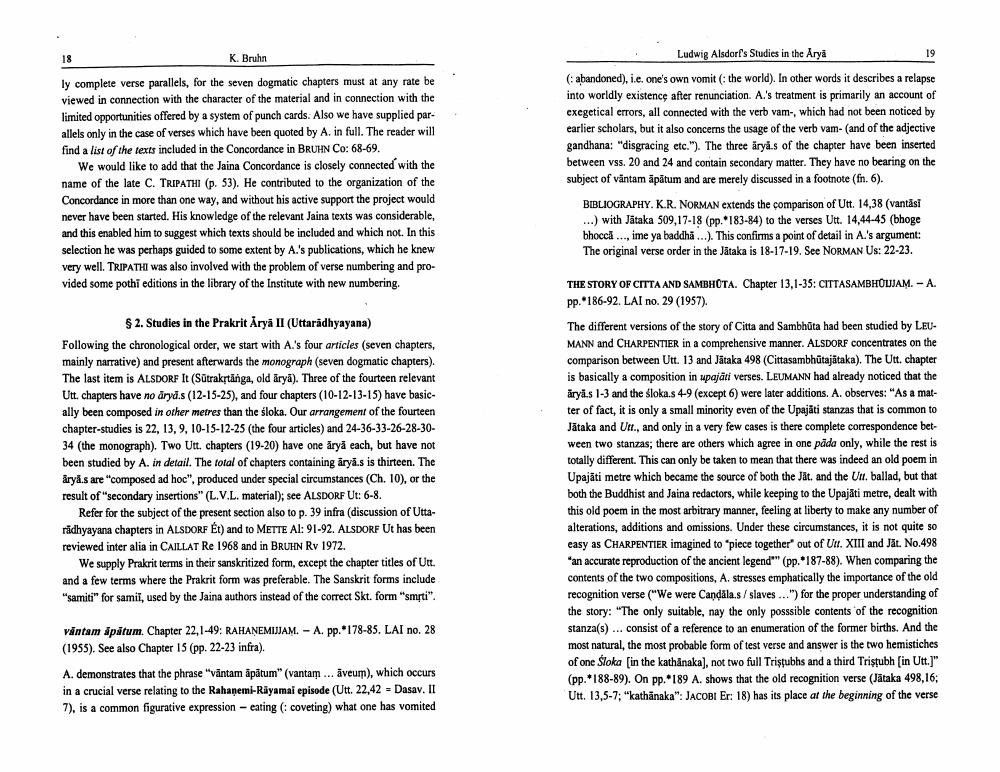Book Title: Ludwig Alsdorfs Studies In Arya Author(s): Klaus Bruhn Publisher: Klaus Bruhn View full book textPage 7
________________ K. Bruhn Ludwig Alsdorf's Studies in the Arya ly complete verse parallels, for the seven dogmatic chapters must at any rate be viewed in connection with the character of the material and in connection with the limited opportunities offered by a system of punch cards. Also we have supplied parallels only in the case of verses which have been quoted by A. in full. The reader will find a list of the texts included in the Concordance in BRUHN Co: 68-69. We would like to add that the Jaina Concordance is closely connected with the name of the late C. TRIPATHI (p. 53). He contributed to the organization of the Concordance in more than one way, and without his active support the project would never have been started. His knowledge of the relevant Jaina texts was considerable, and this enabled him to suggest which texts should be included and which not. In this selection he was perhaps guided to some extent by A.'s publications, which he knew very well. TRIPATHI was also involved with the problem of verse numbering and provided some pothi editions in the library of the Institute with new numbering. (abandoned), i.e. one's own vomit (the world). In other words it describes a relapse into worldly existence after renunciation. A.'s treatment is primarily an account of exegetical errors, all connected with the verb vam-, which had not been noticed by earlier scholars, but it also concerns the usage of the verb vam- (and of the adjective gandhana: "disgracing etc."). The three arya.s of the chapter have been inserted between vs. 20 and 24 and contain secondary matter. They have no bearing on the subject of vantam āpātum and are merely discussed in a footnote (fn. 6). BIBLIOGRAPHY. K.R. NORMAN extends the comparison of Utt. 14,38 (vantasi ...) with Jataka 509,17-18 (pp.*183-84) to the verses Utt. 14.44-45 (bhoge bhocca ..-, ime ya baddha ...). This confirms a point of detail in A's argument: The original verse order in the Jataka is 18-17-19. See NORMAN Us: 22-23. THE STORY OF CITTA AND SAMBHOTA. Chapter 13,1-35: CITTASAMBHOUJAM.-A. pp. 186-92. LAI no. 29 (1957). $ 2. Studies in the Prakrit Årya II (Uttaradhyayana) Following the chronological order, we start with A's four articles (seven chapters, mainly narrative) and present afterwards the monograph (seven dogmatic chapters). The last item is ALSDORF It (Sütraktänga, old äryä). Three of the fourteen relevant Utt. chapters have no aryd.s (12-15-25), and four chapters (10-12-13-15) have basic ally been composed in other metres than the sloka. Our arrangement of the fourteen chapter-studies is 22, 13, 9, 10-15-12-25 (the four articles) and 24-36-33-26-28-3034 (the monograph). Two Utt. chapters (19-20) have one äryä each, but have not been studied by A. in detail. The total of chapters containing arya.s is thirteen. The Arya.s are "composed ad hoc", produced under special circumstances (Ch. 10), or the result of "secondary insertions" (L.V.L. material); see ALSDORF Ut: 6-8. Refer for the subject of the present section also to p. 39 infra (discussion of Uttaridhyayana chapters in ALSDORF Et) and to METTE AL: 91-92. ALSDORF Ut has been reviewed inter alia in CAILLAT Re 1968 and in BRUHN Rv 1972. We supply Prakrit terms in their sanskritized form, except the chapter titles of Utt. and a few terms where the Prakrit form was preferable. The Sanskrit forms include "samiti" for samii, used by the Jaina authors instead of the correct Skt. form "smrti". The different versions of the story of Citta and Sambhūta had been studied by LEUMANN and CHARPENTIER in a comprehensive manner. ALSDORF concentrates on the comparison between Utt. 13 and Jätaka 498 (Cittasambhūtajātaka). The Utt. chapter is basically a composition in wpajati verses. LEUMANN had already noticed that the äryä.s 1-3 and the sloka.s 4-9 (except 6) were later additions. A. observes: "As a matter of fact, it is only a small minority even of the Upajati stanzas that is common to Jätaka and Urr., and only in a very few cases is there complete correspondence between two stanzas; there are others which agree in one päda only, while the rest is totally different. This can only be taken to mean that there was indeed an old poem in Upajati metre which became the source of both the Jat, and the Un, ballad, but that both the Buddhist and Jaina redactors, while keeping to the Upajāti metre, dealt with this old poem in the most arbitrary manner, feeling at liberty to make any number of alterations, additions and omissions. Under these circumstances, it is not quite so easy as CHARPENTIER imagined to "piece together out of Un. XIII and Jät. No.498 "an accurate reproduction of the ancient legend" (pp.*187-88). When comparing the contents of the two compositions, A. stresses emphatically the importance of the old recognition verse ("We were Candala.s / slaves...") for the proper understanding of the story: "The only suitable, nay the only possible contents of the recognition stanza(s) ... consist of a reference to an enumeration of the former births. And the most natural, the most probable form of test verse and answer is the two hemistiches of one Sloka (in the kathanaka), not two full Trisfubhs and a third Tristubh (in Utt.]" (pp.*188-89). On pp.*189 A. shows that the old recognition verse (Jätaka 498,16; Utt. 13,5-7; "kathanaka": JACOBI Er: 18) has its place at the beginning of the verse vántam spátum. Chapter 22,1-49: RAHANEMIJJAM. - A. pp.* 178-85. LAI no. 28 (1955). See also Chapter 15 (pp. 22-23 infra). A. demonstrates that the phrase "väntam apātum" (vantam... äveur), which occurs in a crucial verse relating to the Rahaņemi-Rayamai episode (Utt. 22,42 - Dasav. II 7), is a common figurative expression - eating (: coveting) what one has vomitedPage Navigation
1 ... 5 6 7 8 9 10 11 12 13 14 15 16 17 18 19 20 21 22 23 24 25
